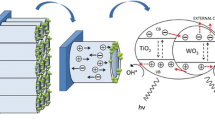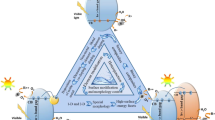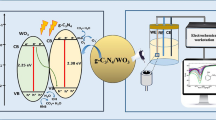Abstract
Environmental pollution treatment is a pressing global issue, and the development of eco-friendly and cost-effective pollution remediation technologies is crucial. We reported the synthesis and full characterization of WO3 nanotubes, featuring a diameter of 10–15 nm and lengths extending up to several micrometers. Spherical Au nanoparticles (NPs) grew randomly on the surface of the WO3 nanotubes. These nanotubes were employed for the photocatalytic degradation of the organic contaminant Rhodamine B. Notably, the WO3–Au nanotubes exhibited exceptional performance in the adsorption and photodegradation of Rhodamine B, achieving an impressive 95.6% removal rate. This enhancement can be attributed to the effective separation of photogenerated charge carriers, the extension of light absorption into the visible region, and the surface plasmon resonance (SPR) effect and Schottky barrier formed by the Au nanoparticles. The proposed photocatalytic mechanism explains the step-by-step degradation of Rhodamine B by utilizing the unique properties of the nanotubes. Recycling experiments demonstrated the stability of the photocatalyst, highlighting its potential for water purification applications. These findings emphasize the promising role of WO3–Au nanotubes as efficient photocatalysts for environmental remediation.






Similar content being viewed by others
References
R. Daghrir, P. Drogui, D. Robert, Photoelectrocatalytic technologies for environmental applications. J. Photochem. Photobiol. A 238, 41–52 (2012)
G. Zheng, J. Wang, H. Liu, V. Murugadoss, G. Zu, H. Che, C. Lai, H. Li, T. Ding, Q. Gao, Z. Guo, Tungsten oxide nanostructures and nanocomposites for photoelectrochemical water splitting. Nanoscale 11, 18968–18994 (2019)
Y. Wicaksana, S. Liu, J. Scott, R. Amal, Tungsten trioxide as visible light photocatalyst for volatile organic carbon removal. Molecules 19, 17747–17762 (2014)
X.S. Rong, F. Qiu, J. Yan, H. Zhao, X. Zhu, D. Yang, Coupling with a norrow-band-gap semiconductor for enhancement of visible-light photocatalytic activity: preparation of Bi2S3/g-C3H4 and application for degradation of RhB. RSC Adv. 5, 24944–24952 (2015)
H. Zhang, G. Chen, D.W. Bahnemann, Photoelectrocatalytic materials for environmental applications. J. Mater. Chem. 19, 5089–5121 (2009)
T. Govindaraja, C. Mahendran, V.S. Manikandan, J. Archanab, M. Shkirc, J. Chandrasekaran, Fabrication of WO3 nanorods/RGO hybrid nanostructures for enhanced visible-light-driven photocatalytic degradation of ciprofloxacin and rhodamine B in an ecosystem. J. Alloys Compd. 868, 159091 (2021)
J. Zhang, X. Fu, H. Hao, W. Gan, Facile synthesis 3D flower-like Ag@WO3 nanostructures and applications in solar-light photocatalysis. J. Alloys Compd. 757, 134–141 (2018)
A. Sclafani, L. Palmisano, G. Marci, A.M. Venezia, Influence of platinum on catalytic activity of polycrystalline WO3 employed for phenol photodegradation in aqueous suspension. Sol. Energy Mater. Sol. Cells 51, 203–219 (1998)
G. Zhang, W. Guan, H. Shen, X. Zhang, W. Fan, C. Lu, H. Bai, L. Xiao, W. Gu, W. Shi, Organic additives-free hydrothermal synthesis and visible-light-driven photodegradation of tetracycline of WO3 nanosheets. Ind. Eng. Chem. Res. 53, 5443–5450 (2014)
G.R. Bamwenda, H. Arkawa, The visible light induced photocatalytic activity of tungsten trioxide powders. Appl. Catal. A 210, 181–191 (2001)
H. Najafi-Ashtiani, The effect of different surface morphologies on WO3 and WO3–Au gas-sensors performance. J. Mater. Sci. Mater. Electron. 30, 12224–12233 (2019)
Y. Hu, L. Hao, Y. Zhang et al., Defect concentration regulation in nanoflower-like WO3 film and its influence on photocatalytic activity. J. Mater. Sci. Mater. Electron. 32, 9412–9423 (2021)
X. Wang, H. Zhang, L. Liu, W. Li, P. Cao, Controlled morphologies and growth direction of WO3 nanostructures hydrothermally synthesized with citric acid. Mater. Lett. 130, 248–251 (2014)
E. Lassner, W. Schubert, Tungsten—Properties, Chemistry, Technology of the Element, Alloys and Chemical Compounds (Springer, New York, 1999), pp.120–121
S.K. Biswas, J.-O. Baeg, S.-J. Moon, K.-J. Kong, W.-W. So, Morphologically different WO3 nanocrystals in photoelectrochemical water oxidation. J. Nanopart. Res. 14, 667 (2012)
Y. Li, Z. Tang, J. Zhang, Z. Zhang, Fabrication of vertical orthorhombic/hexagonal tungsten oxide phase junction with high photocatalytic performance. Appl. Catal. B 207, 207–217 (2017)
A.P. Manuel, K. Shankar, Hot electrons in TiO2–noble metal nano-heterojunctions: fundamental science and applications in photocatalysis. Nanomaterials 11(5), 1249 (2021)
S.B. Ramakrishnan, F. Mohammadparast, A.P. Dadgar, T. Mou, T. Le, B. Wang, P.K. Jain, M. Andiappan, Photoinduced electron and energy transfer pathways and photocatalytic mechanisms in hybrid plasmonic photocatalysis. Adv. Opt. Mater. 9, 2101128 (2021)
M. Liu et al., Heterostructure nanocomposite with local surface plasmon resonance effect enhanced photocatalytic activity—a critical review. J. Phys. D 55, 043002 (2022)
W. Li, T. Wang, D. Huang, C. Zheng, Y. Lai, X. Xiao, S. Cai, W. Chen, Hexagonal WO3·0.33H2O hierachical microstructure with efficient photocatalytic degradation activity. Catalysts 11, 496 (2021)
M. Zamouche, O. Hamdaoui, Sorption of rhodamine B by cedar cone: effect of pH and ionic strength. Energy Procedia 18, 1228–1239 (2012)
Z. Jiang, F. Yang, G. Yang, L. Kong, M.O. Jones, T. Xiao, P.P. Edwards, The hydrothermal synthesis of BiOBr flakes for visible-light-responsive photocatalytic degradation of methyl orange. J. Photochem. Photobiol. 212, 8–13 (2010)
S.-R. Zhu, Q. Qi, W.-N. Zhao, M.-K. Wu, Y. Fang, K. Tao, F.-Y. Yi, L. Han, Hierarchical core-shell SiO2@PDA@BiOBr microspheres with enhanced visible-light-driven photocatalytic performance. Dalton Trans. 46, 11451–11458 (2017)
J. Kou, C. Lu, J. Wang, Y. Chen, Z. Xu, R.S. Varma, Selectivity enhancement in heterogeneous photocatalytic transformations. Chem. Rev. 117, 1445–1514 (2017)
Acknowledgements
This work has been supported by the research fund of Vietnam Academy of Science and Technology (VAST) with the Grant Number KHCBVL.04/22-23.
Funding
The authors have not disclosed any funding.
Author information
Authors and Affiliations
Contributions
TATD, MTM analyzed data and prepared the manuscript and figures. DTN, QNP, HTG, TGH, THN, and THLN carried out the experiment. TATD, THN and MTM discussed the results, writing—review & editing. TATD and MTM supervised the project. All authors reviewed the manuscript.
Corresponding authors
Ethics declarations
Competing interests
The authors declare that they have no known competing financial interests or personal relationships that could have appeared to influence the work reported in this paper.
Additional information
Publisher's Note
Springer Nature remains neutral with regard to jurisdictional claims in published maps and institutional affiliations.
Rights and permissions
Springer Nature or its licensor (e.g. a society or other partner) holds exclusive rights to this article under a publishing agreement with the author(s) or other rightsholder(s); author self-archiving of the accepted manuscript version of this article is solely governed by the terms of such publishing agreement and applicable law.
About this article
Cite this article
Anh Thu Do, T., Nguyen, D.T., Ho, T.G. et al. Enhanced catalytic activity of WO3–Au nanotubes: mechanism and environmental remediation potential. J Mater Sci: Mater Electron 34, 2246 (2023). https://doi.org/10.1007/s10854-023-11631-z
Received:
Accepted:
Published:
DOI: https://doi.org/10.1007/s10854-023-11631-z




